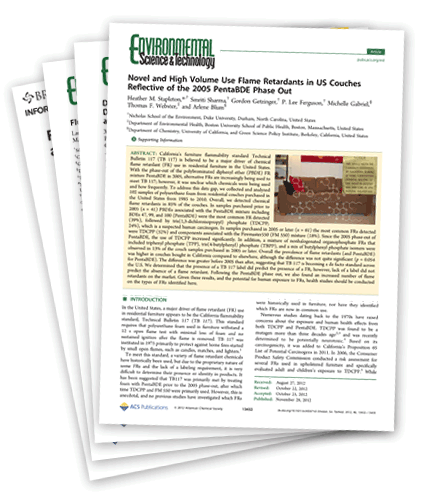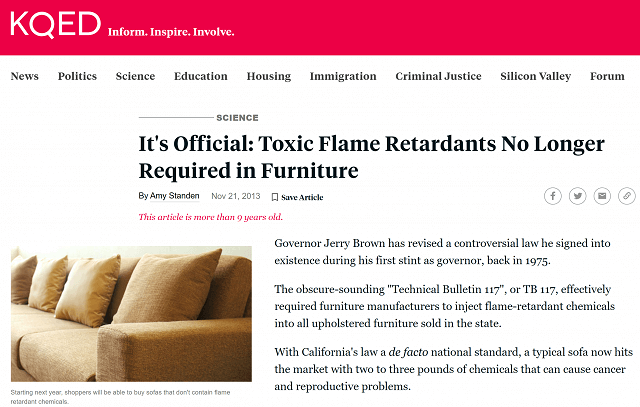Case Study: Flame Retardants in Furniture & Baby Products
Research + Partners + Communications = Change
 Research:
Research:
Beginning in 2009, we collaborated with Heather Stapleton from Duke University and other scientists to measure flame retardants added to foam inside U.S. furniture and baby products in order to meet California’s Technical Bulletin 117 (TB117), an ineffective open-flame furniture flammability standard. We published peer-reviewed papers finding harmful flame retardants in most couches studied in 2009 and 2012 and in most baby products in 2011. During the same time period, we collaborated with leading fire scientist Dr. Vyto Babrauskas on a peer-reviewed paper documenting the lack of fire safety benefit from the TB117 standard. Through our communications efforts described below, these papers educated businesses, governments, firefighters, and NGOs that the flame retardants in our furniture and baby products did not increase fire safety and were harming our population.
Partners:
- We collaborated with California State Senator Mark Leno to draft and promote several bills (including the Consumer Choice Fire Safety Act) that would have replaced California TB117, an open flame standard essentially necessitating flame retardants, with a smolder standard that would increase fire safety without the need for these toxic chemicals.
- We partnered with environmental health NGOs (including NRDC, Coming Clean, the Center for Environmental Health, Physicians for Social Responsibility-Los Angeles, Safer Chemicals Healthy Families, and others) on campaigns around the 2011 baby products paper and legislation.
- We educated leaders and trade associations in the commercial and home furniture, foam, fabric, and children’s product industries as well as firefighters about the harm of flame retardants and lack of fire safety benefit from TB117 and gained the industry’s strong support for updating the old standard.
 Communications:
Communications:
- In February 2011, we helped organize a Sacramento press conference with California State Senator Mark Leno, fire scientists, public health leaders, and environmental advocates to unveil the Consumer Choice Fire Safety Act.
- In May 2011, we published op-eds in the Sacramento Bee and Capitol Weekly in support of the Act.
- Later in May 2011, with our academic and NGO partners, we wrote and pitched a compelling press release around the baby products paper.
- We created and disseminated several fact sheets, brochures, and webpages for consumers to help them reduce exposure to flame retardants in furniture and baby products.
Results:
- Our baby products paper received widespread media attention, including in the New York Times and the CBS Evening News. It was named Environmental Science & Technology’s top paper of 2011, and has been downloaded more than 26,000 times and cited more than 330 times.
- Based in part on this paper, California exempted strollers, infant carriers, nursing pillows, and other children’s products from TB117 and the need for any flame retardants in early 2011.
- In May 2012, the Chicago Tribune published its investigative series (a finalist for the Pulitzer Prize) about the flame retardant industry’s extreme lobbying efforts to keep flame retardants in furniture, including its campaign against the Consumer Choice Fire Safety Act. This high-impact series was sparked by the 2011 hearing for the bill to which we invited the Tribune reporters.
- Jamie Redford and Kirby Walker’s popular HBO documentary “Toxic Hot Seat,” featuring scientists including our Institute, other NGOs, and firefighters working together for an improved furniture flammability standard, brought the story of toxic flame retardants to a much larger audience.
 In June 2012, California Governor Jerry Brown called for a new furniture standard that would improve fire safety by stopping smoldering fires in fabric without the need for flame retardants. This standard (TB117-2013) became mandatory for new furniture manufactured after January 1, 2015. This change of standard led to a reduction in harmful flame retardant usage while maintaining or increasing fire safety, given that the major causes of furniture fires result from smoldering sources like cigarettes or space heaters.
In June 2012, California Governor Jerry Brown called for a new furniture standard that would improve fire safety by stopping smoldering fires in fabric without the need for flame retardants. This standard (TB117-2013) became mandatory for new furniture manufactured after January 1, 2015. This change of standard led to a reduction in harmful flame retardant usage while maintaining or increasing fire safety, given that the major causes of furniture fires result from smoldering sources like cigarettes or space heaters.- In 2014, California passed SB1019, a law requiring upholstered furniture to have a label stating whether or not the item contains flame retardants. This law helped improve product ingredient transparency and bring more attention to the potential harms of chemicals in furniture.
- In 2019, California repealed TB133, another ineffective open-flame standard that led to the addition of harmful flame retardants to the foam in furniture used in hospitals, daycare centers, and other public occupancies.
- On December 21, 2020, the U.S. Congress passed The Safer Occupancy Furniture Flammability Act (SOFFA), which was presented alongside other legislation in a $1.4 trillion COVID relief omnibus bill. SOFFA requires the adoption of California’s TB 117-2013 as a federal flammability standard for residential upholstered furniture. Furniture manufacturers, firefighters, and public health experts all welcomed this important change.